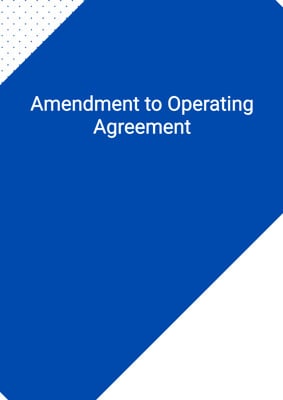How to Tailor the Document for Your Need?
01
Create Document
Fill in the details of the parties. You can click the "Fill with Member’s Information" button to complete it with information saved to your account.
02
Fill Information
Please fill in any additional information by following the step-by-step guide on the left hand side of the preview document and click the "Next" button.
03
Get Document
When you are done, click the "Get Document" button and you can download the document in Word or PDF format.
04
Review Document
Please get all parties to review the document carefully and make any final modifications to ensure that the details are correct before signing the document.
Document Preview
Document Description
The Partnership Agreement is a legally binding document that establishes a partnership between Party 1, Party 2, and Party 3. The agreement outlines the purpose of the partnership, the management structure, and the rights and obligations of each partner. It also includes provisions for the allocation of profits and losses, the contribution of capital, and the termination of the partnership. The agreement is important as it provides a clear framework for the operation of the partnership and helps to prevent disputes and misunderstandings between the partners.
The agreement begins with an interpretation section, which defines key terms used throughout the document. It then sets out the commencement date of the agreement and the business of the partnership. The partnership is established for the purpose of conducting a specific business, and the partners are required to act in the best interests of the partnership and implement the business plan.
The agreement also addresses the capital contributions of each partner. Each partner is required to make an initial contribution to the partnership, and their capital accounts are credited accordingly. The percentage shares of the partners are determined based on their capital contributions.
Further finance may be required during the term of the agreement, and each partner is obligated to contribute their percentage share of any additional funding. The partners are not obliged to provide guarantees for the partnership's financing commitments, but if they do, the liabilities are several and not joint and several.
The agreement includes provisions for the allocation of profits and losses. The amount of profits and losses for each accounting period is determined from the partnership's accounts, and they are allocated to the partners in proportion to their percentage shares. Any cash available to the partnership that is surplus to its requirements can be distributed to the partners based on their respective percentage shares.
The partnership is managed by a partnership board, which is responsible for the overall supervision of the business. The board is comprised of directors appointed by each partner, and it has the authority to act on behalf of the partnership in all matters related to the business. The chairperson and chief executive are also appointed by the partners.
The agreement includes provisions for the appointment and removal of directors, the convening and conduct of partnership board meetings, and the passing of resolutions. Certain matters require unanimity of the partnership board, including changes in the nature or scope of the business, material changes in the organization of the partnership, and the approval of the business plan and budget.
The chief executive is responsible for the day-to-day executive management of the business, and they are assisted by other executive managers. The appointment and terms of reference of the executive managers are subject to the approval of the partnership board.
The partnership's property and assets are beneficially owned by the partners in proportion to their percentage shares. Any property held by one partner on behalf of the partnership is held on trust for the benefit of the partnership.
The partners are subject to certain undertakings, including a restriction on carrying on or being engaged in any competing business during the term of the agreement. Each partner is also obligated to promote the best interests of the partnership and act in good faith towards the other partners.
The agreement includes provisions for the reimbursement of expenses incurred by the partners in the performance of their obligations, the preparation of accounts and budgets, and the provision of information to the partners. It also includes indemnities, default provisions, and confidentiality and announcement requirements.
The agreement can be terminated in certain circumstances, including the occurrence of a fundamental deadlock or a material change in the financial results of the business. Upon termination, the partners are required to consult and agree on an orderly program for winding up the business and distributing its assets.
The agreement contains standard provisions regarding waivers and amendments, severability, notices, governing law, dispute resolution, counterparts, and the rights of third parties. It is important for the partners to carefully review and understand the terms of the agreement before entering into the partnership.
How to use this document?
1. Review the Partnership Agreement carefully to understand its terms and provisions.
2. Ensure that all parties involved in the partnership are identified correctly in the agreement, including their principal place of business.
3. Familiarize yourself with the interpretation section of the agreement to understand the definitions of key terms used throughout the document.
4. Pay attention to the commencement date of the agreement and ensure that it is accurate.
5. Understand the purpose of the partnership and the business it intends to conduct.
6. Review the provisions related to capital contributions and ensure that they accurately reflect the initial contributions made by each partner.
7. Familiarize yourself with the provisions for further finance and understand the obligations of each partner in contributing additional funding.
8. Understand how profits and losses will be allocated among the partners and how any surplus cash will be distributed.
9. Review the provisions related to the partnership board and understand its role in the management of the business.
10. Pay attention to the appointment and removal of directors and understand the requirements for convening and conducting partnership board meetings.
11. Familiarize yourself with the matters that require unanimity of the partnership board and understand the implications of these provisions.
12. Understand the responsibilities of the chief executive and other executive managers in the day-to-day management of the business.
13. Review the provisions related to the partnership's property and assets and understand how they are owned and held.
14. Ensure compliance with the undertakings set out in the agreement, including the restriction on engaging in competing business.
15. Familiarize yourself with the provisions related to expenses, accounts, budgets, and the provision of information to the partners.
16. Understand the indemnities, default provisions, and confidentiality and announcement requirements.
17. Be aware of the circumstances that may lead to the termination of the agreement and understand the process for winding up the business.
18. Seek legal advice if necessary to ensure a thorough understanding of the agreement and its implications.
Not the right document?
Don’t worry, we have thousands of documents for you to choose from:






















































